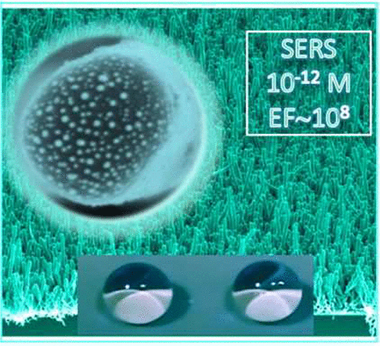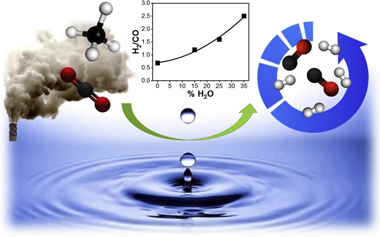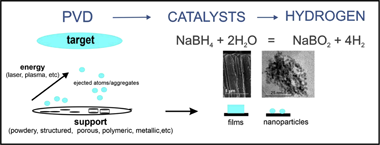Scientific Papers in SCI
2020
2020
Nanotecnología en Superficies y Plasma - Tribología y Protección de Superficies
Plasma-Enabled Amorphous TiO2 Nanotubes as Hydrophobic Support for Molecular Sensing by SERS
Filippin, N; Castillo-Seoane, J; Lopez-Santos, MC; Rojas, CT; Ostrikov, K; Barranco, A; Sanchez-Valencia, JR; Borras, AACS Applied Materials & Interfaces, 12 (2020) 50721-50733
Show abstract ▽

We devise a unique heteronanostructure array to overcome a persistent issue of simultaneously utilizing the surface-enhanced Raman scattering, inexpensive, Earth-abundant materials, large surface areas, and multifunctionality to demonstrate near single-molecule detection. Room-temperature plasma-enhanced chemical vapor deposition and thermal evaporation provide high-density arrays of vertical TiO2 nanotubes decorated with Ag nanoparticles. The role of the TiO2 nanotubes is 3-fold: (i) providing a high surface area for the homogeneous distribution of supported Ag nanoparticles, (ii) increasing the water contact angle to achieve superhydrophobic limits, and (iii) enhancing the Raman signal by synergizing the localized electromagnetic field enhancement (Ag plasmons) and charge transfer chemical enhancement mechanisms (amorphous TiO2) and by increasing the light scattering because of the formation of vertically aligned nanoarchitectures. As a result, we reach a Raman enhancement factor of up to 9.4 × 107, satisfying the key practical device requirements. The enhancement mechanism is optimized through the interplay of the optimum microstructure, nanotube/shell thickness, Ag nanoparticles size distribution, and density. Vertically aligned amorphous TiO2 nanotubes decorated with Ag nanoparticles with a mean diameter of 10–12 nm provide enough sensitivity for near-instant concentration analysis with an ultralow few-molecule detection limit of 10–12 M (Rh6G in water) and the possibility to scale up device fabrication.
November, 2020 | DOI: 10.1021/acsami.0c14087
Química de Superficies y Catálisis
Flexible syngas production using a La2Zr2-xNixO7-delta pyrochlore-double perovskite catalyst: Towards a direct route for gas phase CO2 recycling
le Sache, E; Pastor-Perez, L; Garcilaso, V; Watson, DJ; Centeno, MA; Odriozola, JA; Reina, TRCatalysis Today, 357 (2020) 583-589
Show abstract ▽

The bi-reforming of methane (BRM) has the advantage of utilising greenhouse gases and producing H2 rich syngas. In this work Ni stabilised in a pyrochlore-double perovskite structure is reported as a viable catalyst for both Dry Reforming of Methane (DRM) and BRM. A 10 wt.% Ni-doped La2Zr2O7 pyrochlore catalyst was synthesised, characterised and tested under both reaction conditions and its performance was compared to a supported Ni/La2Zr2O7. In particular the effect of steam addition is investigated revealing that steam increases the H2 content in the syngas but limits reactants conversions. The effect of temperature, space velocity and time on stream was studied under BRM conditions and brought out the performance of the material in terms of activity and stability. No deactivation was observed, in fact the addition of steam helped to mitigate carbon deposition. Small and well dispersed Ni clusters, possibly resulting from the progressive exsolution of Ni from the mixed oxide structure could explain the enhanced performance of the catalyst.
November, 2020 | DOI: 10.1016/j.cattod.2019.05.039
Nanotecnología en Superficies y Plasma
Thermo-optic response of MEH-PPV films incorporated to monolithic Fabry-Perot microresonators
Rostra, JG; Soler-Carracedo, K; Martin, LL; Lahoz, F; Yubero, FDyes and Pigments, 182 (2020) 108625
Show abstract ▽
Poly[2-methoxy-5-(2'-ethylhexyloxy)-1,4-phenylene vinylene] (MEH-PPV) is a semiconducting optically active polymer widely used in optoelectronics research. MEH-PPV can be commercially acquired in a large range of molecular weights. However, the influence of this property on the optical performance of the polymer is often disregarded. In this paper, the thermal dependence of the refractive index of MEH-PPV thin films prepared from high and medium molecular weight polymers is investigated. Thus, monolithic Fabry-Perot (FP) microcavities are fabricated, in which the active polymer film is part of their defect layer. It is found that when these devices are used as optical temperature sensors, the position of the emission band of the microcavities excited with a blue diode laser shifts to lower wavelengths when temperature increases with sensitivities in the 0.2-0.3 nm/degrees C range. This effect is ascribed to the variation in the refractive index of the polymer active layer within the resonator with temperature. According to theoretical simulations of optical transmittance by classical transfer matrix method and the evaluation of the optical eigenmodes by finite element methods of the manufactured FP resonator cavities, it is found that the MEH-PPV films present negative thermo-optic coefficients of about-0.018 K-1 and-0.0022 K-1 for high and medium molecular weight polymers, respectively, in the temperature range between 20 and 60 degrees C. These values are about the highest reported so far, to the best of our knowledge, and points to high performance thermal sensor applications.
November, 2020 | DOI: 10.1016/j.dyepig.2020.108625
Tribología y Protección de Superficies
Tailoring CrNx stoichiometry and functionality by means of reactive HiPIMS
Sanchez-Lopez, JC; Caro, A; Alcala, G; Rojas, TCSurface & Coatings Technology, 401 (2020) 126235
Show abstract ▽
This work presents a complete study of the influence of HiPIMS pulse characteristics on the microstructure, chemical composition, mechanical and oxidation resistance properties of CrN thin films. The investigated parameters were frequency and pulse length at two different nitrogen fluxes, maintaining constant the duty cycle conditions (2%). The effect of a negative bias of 100 V was investigated in a particular case. By changing the synthesis conditions, it was possible to tailor the N/Cr ratio and thus to control the CrNx stoichiometry from x = 0.63 to 1.10. The selection of longer pulses (shorter frequencies) generates more disordered structures with lower N/Cr ratios. This is reflected in higher hardness and elastic modulus values on despite of a lower oxidation resistance due to existence of larger concentration of N vacancies. The best oxidation resistance is obtained at the highest peak current combined with additional ion bombardment provided by substrate biasing. The present results open the possibilities of modifying chemical composition and engineering surfaces by changing exclusively the pulse conditions in HiPIMS deposition processes.
November, 2020 | DOI: 10.1016/j.surfcoat.2020.126235
Materiales Nanoestructurados y Microestructura
Advances in the implementation of PVD-based techniques for the preparation of metal catalysts for the hydrolysis of sodium borohydride
Arzac, GM; Fernandez, AInternational Journal of Hydrogen Energy, 58 (2020) 33288-33309
Show abstract ▽

Sodium borohydride constitutes a safe alternative for the storage of hydrogen with a high gravimetric content. Catalytic hydrolysis of sodium borohydride permits on-demand hydrogen generation for multiple applications. In this field, the rational design of efficient metal catalysts deposited on structured supports is highly desirable. For most reactions, chemical methods are the most commonly used methods for the preparation of supported metal catalysts. Physical vapour deposition techniques are emerging as an alternative for the preparation of catalytic materials because of their multiple advantages. They permit the one-step deposition of catalysts on structured supports with controlled microstructure and composition, avoiding the multi-step procedures and the generation of hazardous by-products associated with chemical routes.
In this short review, we will describe the available literature on the application of physical vapour deposition techniques for the preparation of supported metal catalysts for the hydrolysis of sodium borohydride. The effects of the deposition parameters on the properties of the catalytic materials will be discussed, and strategies for further improvement will be proposed. Here, we also present our new results on the study of nanoporous Pt catalysts that are prepared through the chemical dealloying of magnetron sputtered Pt-Cu thin films for the hydrolysis of sodium borohydride. We discuss the capabilities of the technique to tune the microstructure from columnar to closed porous microstructures, which, coupled with dealloying, produces more active supported catalysts with lower noble metal loading. At the end, we briefly mention the application of PVD for the preparation of supported catalysts for the hydrolysis of ammonia borane, another hydrogen generating reaction of high interest nowadays.
November, 2020 | DOI: 10.1016/j.ijhydene.2020.09.041
- ‹ previous
- 91 of 410
- next ›














